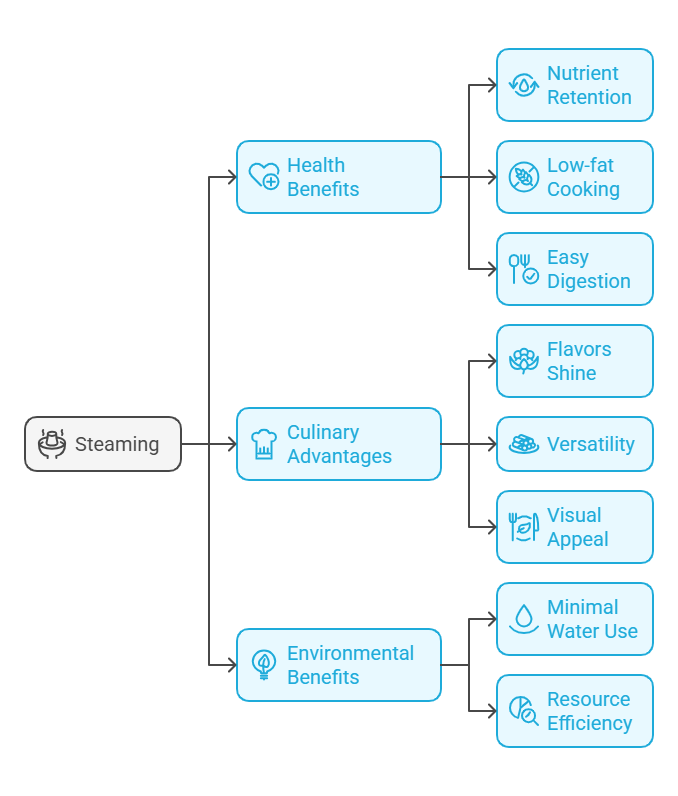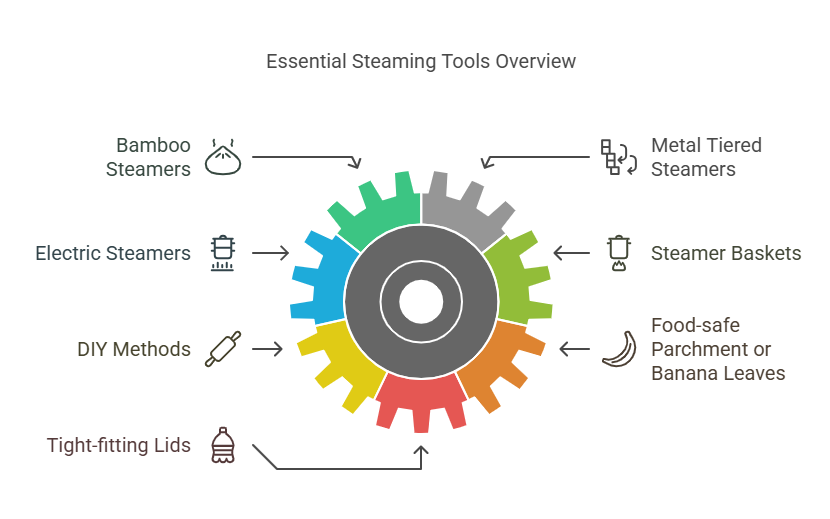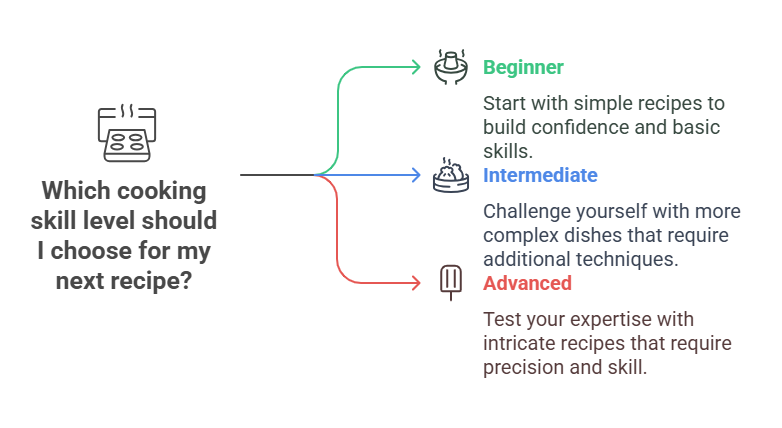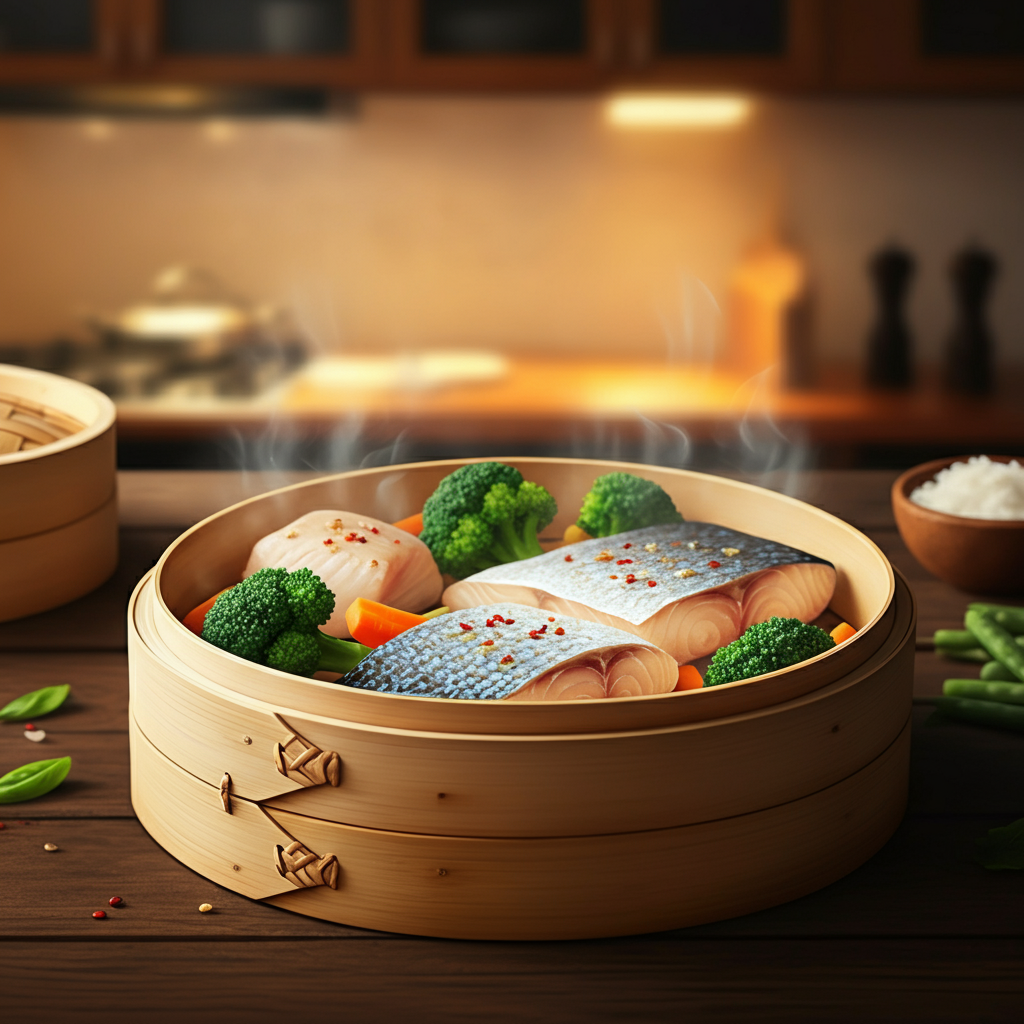Steaming method is having a moment, and for good reason. If you’ve been looking for a cooking technique that keeps food flavorful, preserves nutrients, and doesn’t require you to drench everything in oil, steaming may just be your new best friend. Used across cultures for centuries, this moist heat cooking method is as timeless as it is versatile. Whether you’re steaming delicate fish, crisp vegetables, or even pillowy bao buns, this method works like magic to transform simple ingredients into extraordinary dishes.
But what makes steaming so special? Why is it gaining popularity among home cooks and professionals alike? And most importantly, how can you master this technique in your own kitchen? This guide has all the answers. From tools to tips, we’re covering everything you need to know about steaming. Sit back, grab a cup of tea (which was probably steeped using steam), and get ready to elevate your cooking game!
What Is Steaming Method?
Steaming method uses hot vapor to cook food, gently surrounding it with moist heat instead of boiling it directly in liquid or frying it in oil. The water (or broth, in some cases) stays below the food, and as it boils, the steam rises to cook the items placed above it. What’s great is that your food never comes into contact with the water, so you preserve a lot of the natural juices, nutrients, and textures.
Steaming method belongs to the family of moist heat cooking methods, which also include techniques like braising, boiling, and poaching. However, steaming stands out for being one of the simplest and healthiest options. No added fat. No complicated procedures. Just good, clean cooking with the perfect balance of moisture and heat.
Here’s a fun fact to spice things up (pun intended): Steaming has been used for over 3,000 years, originating as a staple technique in many Asian cuisines. Today, it’s a universal favorite, embraced in everything from Chinese dim sum to Mediterranean fish dishes.
Why does that matter to you?
Because this cooking method works for nearly every cuisine, it’s one of the most versatile tools for any modern kitchen. You can use it to keep your meals exciting and varied, without compromising on health or flavor.
The Health and Culinary Benefits of Steaming Method
Why should you choose steaming over other cooking techniques? Let’s break it down:
1. Health Benefits
- Nutrient Retention
When you boil vegetables, many nutrients—including vitamin C and B vitamins—leach into the water. Steaming method avoids this loss, retaining more of those vital nutrients right in your food, where they belong.
- Low-fat Cooking
Because steaming method doesn’t require oil or butter (unless you choose to add them afterward), it’s one of the healthiest ways to prepare food. It’s perfect for anyone looking to reduce their calorie intake without skimping on taste.
- Easy Digestion
Steamed food is incredibly tender and easier to digest, making it a great option for those with dietary sensitivities or health concerns.
2. Culinary Advantages
- Flavors Shine
Steaming method preserves the natural taste of ingredients, offering clean, vibrant flavors. That broccoli you steam? It tastes like broccoli, not overcooked mush.
- Versatility
From proteins to desserts, steaming method works across the board. Steam chicken, dumplings, veggies, sticky rice—even delicate puddings.
- Visual Appeal
Because there’s less breakdown during cooking, vibrant colors and textures are preserved. Picture crisp green beans or glistening pink salmon fresh from the steamer.
3. Environmental Benefits
Steaming method requires minimal water, making it an eco-friendly option that uses fewer resources. Plus, multi-tiered steamers allow you to cook an entire meal in one go.
Bottom line? Steaming is healthy, sustainable, and downright delicious.

Your Toolkit for Steaming Success
The beauty of steaming method lies in its simplicity, but using the right tools makes all the difference. Here’s your essential equipment rundown:
1. Types of Steamers
- Bamboo Steamers
Eco-friendly, light, and traditional, bamboo steamers are great for cooking multiple layers of food. A must-have for Asian cuisine lovers.
- Metal Tiered Steamers
Durable, versatile, and stackable. Perfect for steaming hearty meals like fish and vegetables.
- Electric Steamers
Great for convenience and precision. Many models allow you to set timers and adjust temperatures.
- Steamer Baskets
A low-cost, adaptable option that fits right into your existing pots.
- DIY Methods
No steamer? No problem! Use a heatproof colander placed over boiling water, or even a plate perched on top of a pot covered with a lid.
2. Optional Add-ons
- Food-safe Parchment or Banana Leaves
Great for wrapping delicate foods or infusing dishes with subtle extra flavors.
- Tight-fitting Lids
Essential for retaining steam efficiency.
Pro Tip: Choose your steamer based on your cooking habits. Bamboo and metal steamers are great for culinary enthusiasts, while electric steamers suit busy kitchens.

How to Steam Food Perfectly
Learning how to steam food isn’t difficult, but mastering the technique takes practice. Here’s a step-by-step guide to make you a steaming pro in no time.
1. Prepping the Steamer
- Fill the pot with a minimal amount of water—just enough to generate steam but not touch your food.
- For bamboo or metal steamers, line the tray with parchment paper if needed, especially for sticky foods.
2. Arranging Food
- Place foods that cook at similar times together.
- Leave space between pieces to ensure even airflow. Overcrowding is a steaming no-go!
3. Cooking Times
Different ingredients require different steaming durations. A quick cheat sheet:
- Vegetables (e.g., broccoli): 5–7 minutes
- Fish Fillets: 8–10 minutes
- Chicken Breasts: 15–20 minutes
- Grains: 30–40 minutes
4. Enhancing Flavors
Want to take things up a notch? Try steaming over aromatic liquids (e.g., broth, wine, or citrus water). Or throw in some fresh herbs, garlic, or ginger for an extra infusion of flavor.
Pro Tip: Always preheat your steamer. Starting with hot steam reduces cooking times and improves texture.
Common Mistakes to Avoid
Even seasoned cooks can fall into these traps. Watch out for these common mistakes:
- Overcrowding
Leads to uneven, soggy food. Stick to single layers or use multiple tiers.
- Neglecting Preheating
Cold steam slows cooking, so start with boiling water.
- Underwhelming Flavor
Failing to use aromatics? You’re missing out on next-level taste.
Avoid these pitfalls, and your steamed dishes will wow every time.
Elevate Your Skills With Recipes
Want to test your newfound knowledge? Start with these easy-to-follow recipes:
Beginner
- Steamed Carrots and Broccoli with Lemon Butter
- Garlic-Ginger Steamed Tilapia
Intermediate
- Chicken Dumplings with Sesame Dipping Sauce
- Vegetarian Bao Buns
Advanced
- Chinese Steamed Fish with Soy and Scallion Sauce
- Vanilla Custard Steamed Pudding
Steaming isn’t just for healthy eating—it’s for delicious eating.

The Future of Steaming Method
With innovations like smart steamers and multifunction appliances, steaming is evolving alongside other cooking techniques. Health-conscious kitchens are turning to it more often, not just for its benefits but also for its convenience. From vegan meals to gluten-free desserts, the possibilities are endless. How will you reinvent steaming in your kitchen?
Share your favorite steaming tips, tricks, or recipes in the comments. We’d love to hear how this age-old method elevates your meals!
And if you’re ready for more cooking inspiration, don’t forget to check out our full guide on moist heat cooking methods for even more culinary breakthroughs.
📌 Stay connected with us!
- Follow us on Instagram: @RoastedKitchen25 for daily cooking inspiration.
- Tag us in your creations using #RoastedKitchensteam—we’d love to see what you make!
Subscribe to our newsletter for exclusive recipes, expert tips, and kitchen hacks straight to your inbox!
FAQ:
- What is steaming method?
Steaming is a moist heat cooking method that uses hot vapor to cook food. The food sits above boiling water, and the rising steam cooks it without direct contact with the liquid. This technique retains nutrients, moisture, and flavor in the food. - What are the benefits of steaming method?
Steaming offers multiple benefits:
- Health benefits like better nutrient retention and no need for added fats.
- It enhances the natural flavors and textures of food.
- Steaming is versatile, eco-friendly, and ideal for delicate ingredients like fish or dumplings.
- What equipment do I need for steaming method?
You can use various tools for steaming:
- Bamboo steamers, metal tiered steamers, or electric steamers.
- Steamer baskets that fit into pots.
- DIY methods using a heatproof colander or plate with a pot and lid.
Choose the equipment based on your needs and kitchen habits.
- How do I steam food perfectly?
To steam food perfectly, follow these steps:
- Fill a pot with enough water to create steam but avoid letting it touch the food.
- Preheat the steamer to start with hot steam.
- Arrange food in a single layer with room for airflow.
- Use a timer to avoid undercooking or overcooking, and enhance flavors with aromatics like herbs or broth.
- What kinds of food can I steam?
Steaming suits a wide range of foods, from vegetables and seafood to poultry, grains, dumplings, and even desserts like custards and puddings. - Can I add flavor to steamed food?
Yes! Enhance the flavor by steaming over aromatic liquids like broth or wine, and add herbs, garlic, or ginger to the water. You can also season food with marinades or spices before steaming. - What are common mistakes to avoid when steaming?
To achieve the best results, avoid these mistakes:
- Overcrowding the steamer, which causes uneven cooking.
- Using too much or too little water.
- Skipping the step of preheating your steamer.
- Not using aromatics to enhance the food’s natural flavors.
- Is steaming environmentally friendly?
Yes! Steaming uses minimal water and allows you to cook multiple items at once with stackable steamers, making it a resource-efficient option. - How do I choose the right steamer for my kitchen?
Consider your cooking habits. Go for bamboo steamers if you love traditional methods, metal steamers for versatility and durability, and electric steamers for convenience and precision. DIY options are great for beginners or occasional use. - Why is steaming considered a healthy cooking method?
Steaming preserves nutrients, doesn’t require fat, and keeps food natural and tender. It’s a gentle method that’s easy to digest, making it perfect for health-conscious meals. - What are some easy recipes I can try with steaming?
Start with beginner-friendly recipes like steamed broccoli and carrots, or garlic-ginger fish fillets. For advanced options, try Chinese-style steamed fish or dumplings for a flavorful challenge. - Does steaming work for meal prep?
Absolutely! Steaming veggies, proteins, or grains in batches is a great way to prepare healthy meals for the week while maintaining their nutritional value.
Got more questions about steaming? Share them in the comments!

Hi, I’m Mayaz Ahsan!
As a passionate cook, storyteller, and food enthusiast, I combine my love for travel, farming, reading, and teaching to bring you insightful culinary tips and stories. Welcome to Roasted Kitchen – I’m thrilled to share this journey with you!










 Subscribe to our free newsletter for tips, tutorials, and insights!
Subscribe to our free newsletter for tips, tutorials, and insights!